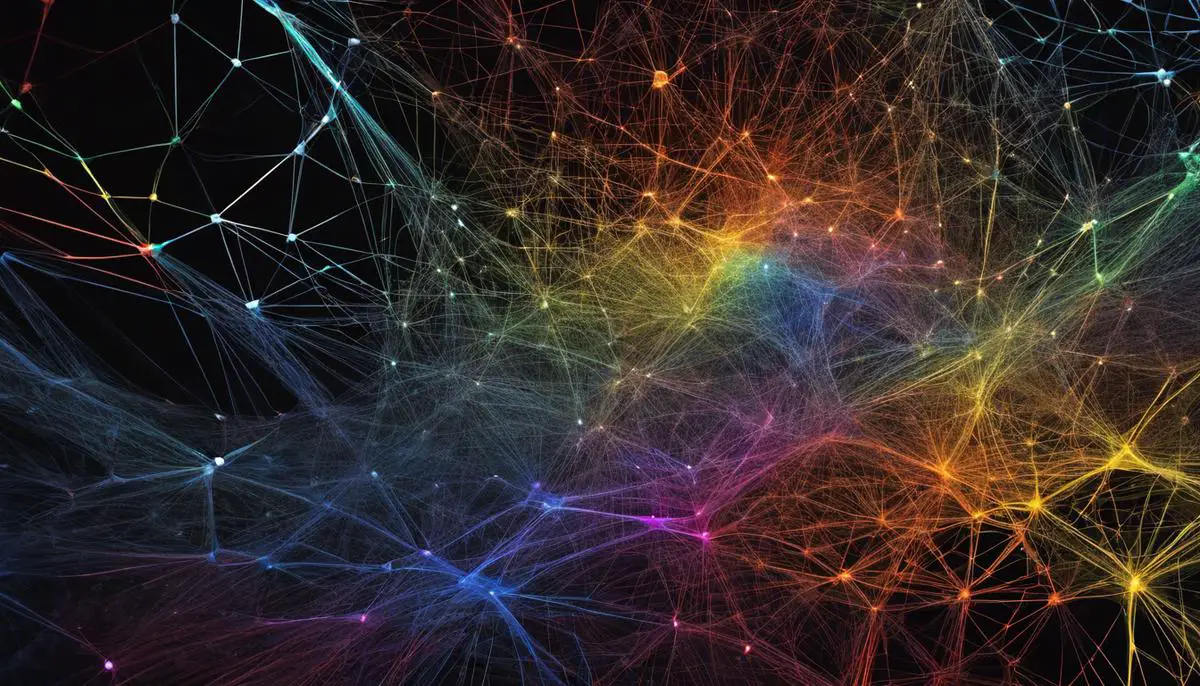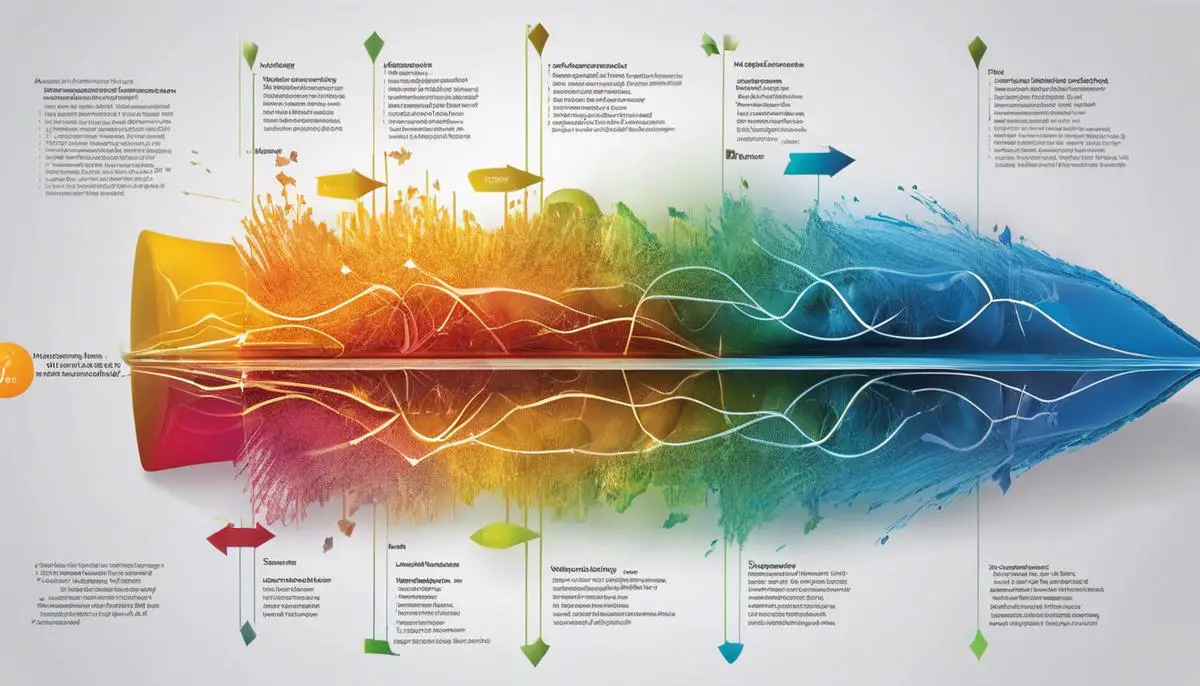As we continue to push the boundaries of artificial intelligence and machine learning, Latent Diffusion Models (LDMs) emerge as a seminal breakthrough, offering an unprecedented lens through which we can explore the world of generative models. These sophisticated constructs stand at the epicenter of an evolving landscape where creativity and computational prowess converge. In this essay, we embark on a meticulous journey to unravel the layers that compose the foundations and intricate architecture of latent diffusion models. We’ll dissect their mechanism of action, probe the training and optimization strategies employed to hone their capabilities, and illuminate the multifaceted applications that these models promise to enhance. Together, let’s delve into the complex tapestry of latent diffusion dynamics, decoding the secrets that enable them to simulate and even surpass the nuances of human creativity.
Contents
Fundamentals of Latent Diffusion Models
Unveiling the Core Principles of Latent Diffusion Models
Latent Diffusion Models represent one of the most promising frontiers in the realm of generative modeling, a sub-field of machine learning that concerns itself with the construction of systems which can generate high-fidelity, novel data samples from learned representations. The foundations of these models rest on a sophisticated understanding of stochastic processes and dimensionality reduction, allowing machines to uncover and manipulate the underlying structure of complex data. This discourse aims to elucidate the fundamental tenets that govern Latent Diffusion Models, thereby offering a glimpse into the ingenious mechanisms that enable these artificial architectures to perform tasks with unprecedented creativity and precision.
The inception of diffusion models is marked by the adaptation of non-equilibrium thermodynamics principles, specifically the concept of a diffusion process. Essentially, diffusion models gradually transform data by adding noise until the signal is indistinguishable from random Gaussian noise. The generative model is then tasked with learning a reverse process, which involves systematically denoising to recreate the original data.
Latent Diffusion Models refine this process by operating not on the raw data itself, but rather on a compressed, latent representation of the data. By so doing, Latent Diffusion Models combine the strengths of variational autoencoders (VAEs) and traditional diffusion models. From the VAEs, these models inherit the capability to encode data into a lower-dimensional space, effectively summarizing the salient features while discarding superfluous details. Utilizing this compact latent space serves a dual purpose: it makes the diffusion process computationally more tractable and focuses the model’s attention on the most critical features of the data.
A cornerstone of Latent Diffusion Models is the denoising process. At each step, the model predicts the noise that was added in the forward process and subsequently reverses this action. This is an iterative operation, often requiring hundreds of steps to transform the noise back into a coherent data point. The objective function, optimized during training, measures the discrepancy between the predicted noise and the actual noise that was added during the forward process. Mastery of this denoising strategy is pivotal for the generation of coherent and high-quality samples.
Underpinning these methodologies is the score-based model, which estimates the gradient of the data distribution with respect to the data itself. In brief, it calculates the direction in which one should modify the noised data to increase its probability under the model’s learned distribution. This score, when combined with specific noise-removal algorithms, orchestrates the transition from disordered noise to structured data.
The synthesis of samples from a Latent Diffusion Model unfolds as a controlled and gradual unraveling of complexity, meticulously orchestrated from start to finish. Starting from a point in the latent space equivalent to random noise, the model incrementally applies the learned denoising policy, effectively retracing the path back to the data manifold it has learned to represent. With each step, coherence is restored until, finally, a new instance materializes—bearing the hallmarks of the input data yet without being a mere reproduction.
Latent Diffusion Models open avenues for a variety of applications, from the enhancement of image quality to the generation of artificial yet lifelike media. Beyond mere generative feats, these models have wider implications for understanding how to represent and process information efficiently, potentially paving the way for advancements across diverse scientific and technological domains. As researchers and practitioners continue to refine and apply these models, the boundary between the synthetic and the authentic will increasingly blur, heralding a new epoch in the confluence of data, art, and science.

Architecture of Latent Diffusion Models
Latent diffusion models represent a pivotal convergent point where the potentiality of generative machine learning is being pushed to its limits. At its core, architecture is foundational in shaping a model’s efficacy and the quality of its output. For latent diffusion models to achieve optimal performance, several architectural elements are meticulously designed and fine-tuned.
One of the key architectural components that augment performance in latent diffusion models is the utilization of sophisticated probabilistic models, such as normalizing flows or Gaussian diffusion processes, to modulate the latent space. By employing these structures, the model gains the ability to make more nuanced transformations in the data representation, leading to a richer generative process.
Furthermore, the performance of latent diffusion models is heavily reliant on the progressive training schedule that permits the model to build complexity incrementally. This training regime simulates a forward diffusion process to corrupt data, followed by a reverse diffusion process to reconstrue it. By iterating over increasingly less noisy versions of the data, the model gradually learns to craft more refined samples.
Effective performance also depends on strategic hyperparameter selection, such as the length of the diffusion chain and the noise schedule. A properly calibrated noise schedule ensures that the diffusion process introduces and reverses noise in a manner that facilitates the recovery of the original data distribution without overcomplicating the reconstruction task.
Another pivotal aspect is the architectural design choices concerning the neural network models that serve as denoisers. Networks with architectures capable of capturing high-level abstractions, like Transformer or U-Net, have been instrumental in enhancing generative performance by adeptly handling the complex spatial relationships in the data.
Moreover, there is an ever-growing interest in integrating attention mechanisms at various points in the neural network architecture. These mechanisms enable a focused processing of features within the latent representations, allowing the model to prioritize more relevant patterns during the generation process. This focused approach helps in the synthesis of outputs that are not only high-quality but also contextually coherent.
Additionally, in seeking peak performance, latency and computational efficiency have been addressed by designing models that can function effectively even with lower computational resources. Techniques such as model distillation and pruning have been employed to compress the model size without significantly compromising generative capacities.
In amalgamating these various architectural elements, a synergy is achieved, which allows latent diffusion models to prudently navigate the intricate balance of performance optimization. Through dynamic research and continuous architectural refinements, latent diffusion models are evolving into sophisticated tools capable of transcending traditional generative limits, elucidating paths for transformative advancements across an expanding canvas of applications.

Training and Optimization
Having delineated the foundational aspects of latent diffusion models, including their synthesis with variational autoencoders and the refinement of the diffusion and denoising processes, there remains a need to discuss the strategies for training these intricate models effectively.
A paramount concern in training latent diffusion models is the management of the vast dimensionality of the data space. This challenge is decisively tackled by employing sophisticated probabilistic models that modulate the diffusion process. These models necessitate a judicious balance between model complexity and generalization capabilities.
The progressive training schedule, a quintessential aspect devoid of which training stability might be compromised, is another focal point. Introducing noise gradually and scaling it back in phases ensures that latent diffusion models can learn to denoise data effectively, developing proficiency in data reconstruction commensurate with the diffusion steps.
Hyperparameter selection remains a meticulous task. The length of the diffusion chain and the noise schedule are determined with high precision, calibrated to accommodate the specific characteristics of the dataset in use. Short diffusion chains are adept for less complex datasets, while longer chains might be essential for capturing the intricacies of high-dimensional data.
Architectural design choices for denoisers are under constant scrutiny and innovation. State-of-the-art architectures such as Transformer and U-Net are employed, with each structure providing unique advantages. The inherent capabilities of these architectures to process and synthesize information are leveraged to amplify the proficiency of latent diffusion models.
The integration of attention mechanisms within these architectures allows for a heightened focus on relevant features within the data, fostering improved synthesis and representation of intricate patterns. This targeted approach ensures that computational resources are allocated efficiently, contributing to the generation of more accurate and coherent samples.
Addressing latency and computational efficiency are of paramount concern, leading to a focus on model compression techniques. Pruning, which streamlines the network by removing superfluous weights, and distillation, which transfers knowledge from a larger model to a smaller one, are methods employed to ensure that the latent diffusion models remain both powerful and agile.
In conclusion, the synergy of architectural elements in latent diffusion models represents the confluence of robust probabilistic modeling, meticulous training strategies, and computational efficiency. The culmination of these components enables latent diffusion models to transcend traditional generative modeling, holding promise for transformative advancements across a breadth of applications that challenge the frontiers of artificial intelligence and machine learning.

Applications of Latent Diffusion Models
The transformative potential of latent diffusion models (LDMs) extends far beyond the initial applications in artificial media synthesis. An examination of emerging areas reveals that LDMs are poised to revolutionize several interdisciplinary fields.
Quantum Chemistry and Material Sciences
In the realm of quantum chemistry and material sciences, LDMs have shown promise in the precise modeling of molecular structures and the prediction of chemical properties. The capacity of latent diffusion models to generate and control complex chemical compound representations could pave the way for unprecedented advancements in drug discovery and material design, potentially expediting the development of novel therapeutics and advanced materials with desired properties.
Climate Modeling
Climate models can benefit from the introduction of LDMs through the augmentation of historical and predictive climate data. By synthesizing extensive climate patterns from limited sample data, LDMs could enhance the accuracy of long-term climate forecasts and assist in the modeling of severe weather events, a critical step for adaptation and mitigation strategies in the face of a changing climate.
Astronomy and Space Exploration
In astronomy and space exploration, LDMs facilitate the interpretation of vast data sets, including high-resolution simulation of celestial phenomena and reconstruction of cosmic events. By bridging gaps in sparse observational data, LDMs enable researchers to hypothesize about the structure and evolution of the universe and contribute to the planning and optimization of space missions.
Natural Language Processing (NLP)
In the field of NLP, latent diffusion models have the potential to enhance language generation and understanding by capturing the nuanced distributions of linguistic patterns. The implications of LDMs in NLP encompass improvements in machine translation, semantic analysis, and the creation of more humanlike interactions in conversational AI agents.
Predictive Modeling in Finance and Economics
The financial sector could harness the potential of LDMs for predictive modeling, risk assessment, and simulation of market scenarios. By accurately summarizing complex economic indicators into latent representations, LDMs offer a means to anticipate market trends and to model the nonlinear dynamics of financial instruments, thus providing valuable insights for decision-making in economics and finance.
Healthcare and Biomedical Engineering
Within healthcare, LDMs are instrumental in processing medical imaging data, enabling the reconstruction of high-fidelity, three-dimensional models from limited input. Such advancements in medical imaging could greatly enhance diagnostic accuracy and the customization of patient-specific treatments. Furthermore, LDMs have the potential to assist in the synthesis of biomedical data, contributing to the understanding of disease patterns and the prediction of health outcomes.
Autonomous Systems and Robotics
The application of LDMs in autonomous systems and robotics involves the interpretation of sensory data to inform decision-making in real time. The models’ ability to infer complete representations from partial observations could lead to significant improvements in the sophistication and adaptability of autonomous agents, thereby expanding the boundaries of robotics and AI-guided systems.
In conclusion, the exploration of latent diffusion models in these areas illustrates the profound capacity for these systems to augment human ingenuity across multiple domains. As research continues, the potential for LDMs to provide transformative contributions to complex problem-solving and the advancement of human knowledge is boundless, promising a future wherein the interplay of artificial intelligence and human endeavor yields unprecedented achievements.

Challenges and Limitations
Despite these significant strides in the latent diffusion model framework, challenges and limitations persist that warrant thorough examination and innovative problem-solving approaches. These challenges can be viewed as opportunities for future study and improvement.
One perturbing limitation of current latent diffusion models is the issue of computational resource consumption. While advancements in model compression and attention mechanisms have somewhat mitigated these concerns, the generation of high-quality samples still requires a substantial amount of computational power, which can limit accessibility for smaller research entities and precludes extensive experimentation.
Moreover, the trade-off between model complexity and interpretability remains a quandary in this domain. As the architectures grow more elaborate to capture intricate data structures, the transparency of the models tends to diminish. This raises concerns for researchers who prioritize the understanding of model workings for analytical purposes, a particularly acute issue in fields requiring rigorous validation and explanation, such as healthcare.
Data diversity and representativeness also present ongoing challenges. Models are often trained on datasets that do not fully capture the heterogeneity of the real world, leading to potential biases in generated results. Ensuring that latent diffusion models are trained on diverse and representative datasets is critical to ensure the universal applicability and fairness of these models.
The training stability of these models is yet another concern that researchers have been attempting to address. The iterative denoising process inherent in latent diffusion models can sometimes lead to training instabilities, particulary when working with complex or high-dimensional data structures. Continued research into more stable and robust training methods is vital for ensuring the consistency and reliability of the generated outcomes.
In the arena of application-specific challenges, each domain poses its own sets of constraints and requirements that latent diffusion models must meet. For example, in natural language processing, models must not only produce syntactically correct sequences but also capture subtleties such as context, tone, and semantics, which remain non-trivial for current architectures.
Last but not least, ethical and societal implications of the technology shape another realm of challenges. The ease of generating artificial media using these models raises concerns regarding the propagation of misinformation and the potential misuse in creating deepfakes. Establishing ethical guidelines and robust detection mechanisms becomes an imperative countermeasure to these issues.
The future of latent diffusion models lies in the delicate balance between the pursuit of model sophistication and the maintenance of computational efficiency, robustness, and ethics. This intricate interplay continues to set the stage for groundbreaking research and transformative applications as the field evolves.

Future Perspectives in Latent Diffusion Models
The Pursuit of Enhanced Training Protocols in Latent Diffusion Models
In the continual quest to cultivate more sophisticated latent diffusion models, there lies a distinct emphasis on the development and refinement of training protocols. It is widely acknowledged that the efficacy of such models is inextricably linked to the procedures employed during their training phase. The field anticipates several enhancements that may reshape the landscape of generative modeling.
Among these anticipated advancements is the heightened focus on adversarial training techniques. While generative adversarial networks (GANs) have prompted significant strides within the domain, the amalgamation of adversarial concepts within the training of latent diffusion models presents a promising frontier. By posing a dynamic challenge during the learning process, where part of the network aims to deceive while the other ascertains truth from falsity, it is projected that such integration could substantially elevate the verisimilitude and novelty of generated outputs.
Further, the exploration of multimodal training processes, facilitating models to interpret and synthesize information across various domains (e.g., visual, auditory, and textual data), is poised to expand the utility of latent diffusion models. The traction gained by multimodal systems showcases a potential trajectory towards a holistic understanding and generation of complex data structures. This development is not merely additive but transformative, potentially birthing models that transcend the limitations of single-modality representations.
An additional vein of progress rests in the personalized tailoring of models to fit specific user needs and preferences, thereby crafting custom diffusion pathways. As different applications warrant different levels of detail and forms of content, the functionality to adjust model parameters in accordance to targeted outcomes is a feature likely to see sophisticated enhancements. It is envisioned that through meta-learning algorithms, which allow models to rapidly adapt to new tasks, latent diffusion models will become more versatile and adept at catering to myriad use cases.
Lastly, the conscientious development of robust frameworks for ethical governance and mitigation of biases within latent diffusion models warrants attention. The increasing capabilities of generative models also amplify the potential for misuse and propagation of biased or harmful content. Proactive research into mechanisms for detecting and correcting biases, alongside the establishment of ethical guidelines for model deployment, will be imperative to ensure that the advancements in this field yield positive and equitable impacts on society.
As these areas of research advance, the community remains committed to a rigorous evaluation of model performance and societal implications. It is this balance—of technological prowess with ethical consideration—that will define the trajectory of latent diffusion models. By navigating these waters with both scientific rigor and responsible foresight, the future of generative modeling not only appears ingenious but also empathetic to the intricate tapestry of human concerns.

The exploration of Latent Diffusion Models presents an enthralling vista into the possibilities of modern generative AI. Through this examination, we have traversed the foundational pillars, surveyed the architectural marvels, embraced the rigorous discipline of training, celebrated the myriad of applications, and acknowledged the prevailing challenges of LDMs. They stand as testaments to the relentless pursuit of knowledge and innovation in the field of artificial intelligence. As these models continued to be refined and expanded, they promise to carve paths through uncharted territories, laying the groundwork for a future where artificial creativity is not just imitative, but palpably transformative. It is this odyssey through the evolution of latent diffusion models that beckons us to peer into the horizon, anticipating the dawn of new insights and breakthroughs that will redefine the essence of machine ingenuity.

Emad Morpheus is a tech enthusiast with a unique flair for AI and art. Backed by a Computer Science background, he dove into the captivating world of AI-driven image generation five years ago. Since then, he has been honing his skills and sharing his insights on AI art creation through his blog posts. Outside his tech-art sphere, Emad enjoys photography, hiking, and piano.
